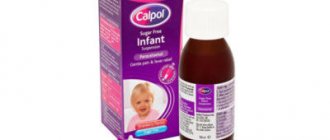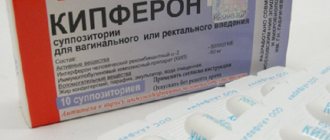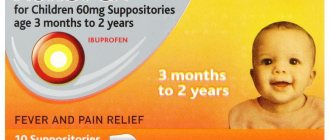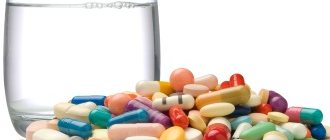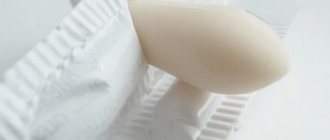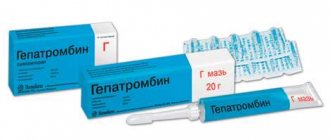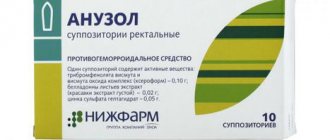Description
Acute respiratory viral diseases are common in pediatric practice.
To prevent exacerbation and development of complications, it is necessary to contact your doctor in a timely manner. Adequate therapy includes etiotropic, pathogenetic and symptomatic effects on the pathology. The main condition for treatment is safety along with high efficiency. Laferobion is a drug from the group of immunostimulants. Consists of alpha-2b recombinant human interferon, which determines the therapeutic effects of the drug. Interferons were discovered in 1957 by A. Isaacs and D. Lindeman.
The mechanism of action is characterized by its influence on the production of its own T- and B-lymphocytes and the normalization of the content of immunoglobulin E. Particular activity of interferons is manifested during the period of virus replication - this helps to reduce the concentration of infectious agents in the blood and tissues.
The drug Laferobion has the following actions:
- complex antiviral;
- antimicrobial;
- antichlamydial;
- antiproliferative;
- immunomodulatory.
Interferon, included in Laferobion, is produced without the use of donor blood. Laferobion exists in several dosage forms and dosages:
- nasal drops and spray;
- lyophilisate for solution for injection;
- suppositories.
Among the advantages of suppositories for ARVI in children is better bioavailability of drugs compared to nasal forms of interferons. Suppositories are not transformed by the liver, so the risk of interaction with concomitant drug therapy is minimal, and accordingly, side effects develop less frequently.
The presence of tocopherol acetate and ascorbic acid as additional components of suppositories enhances the antiviral activity of interferon.
Laferobion is used in pediatric practice according to the recommended doses in the instructions for use after consultation with your doctor. No cases of overdose have been recorded to date.
Laferobion is indicated in the complex treatment of acute respiratory viral infections, as well as for immune correction in diseases of viral etiology.
Before starting to use any of the dosage forms of Laferobion, you should consult a medical specialist.
How to use
Children's suppositories Laferobion are inserted into the anus. Before use, allow the candle to sit in the refrigerator for some time or keep it under running cold water to allow the fat to harden. Then the product does not melt so quickly in your hands.
The procedure for administering suppositories is as follows::
- wash hands with soap;
- carefully remove the candle from the wrapper;
- if half the dose is prescribed, then the candle is carefully cut in half with a disinfected blade;
- the rectal area is moistened with cool water;
- put the child on his side, straighten one leg, bend the other at the knee, open the rectal area, lifting the upper buttock;
- a suppository is inserted above the muscular sphincter to a depth of approximately 2.5 cm;
- bring the buttocks together and lay the child on his side so that he lies there for 5 minutes - this prevents the candle from coming out;
- wash your hands thoroughly.
Why and how to give Pirantel to a child? We will tell you all the details of taking this anthelmintic drug!
Instructions for using Ibuklin tablets for children are presented in this article.
The dosage of Amoxiclav suspension for children and methods of taking it are described informatively in our next review.
Pharmacological properties
Armacodynamics .
Interferon alpha-2b recombinant has a pronounced antiviral, antiproliferative and immunomodulatory effect. The active substance of the drug Laferobion®, recombinant interferon alpha-2b, has an immunomodulatory effect on T- and B-lymphocytes, normalizes the content of immunoglobulin E, and has antiviral activity. Antibodies that neutralize the antiviral activity of recombinant interferon alpha-2b are not formed, even when used for 2 years, the functioning of the endogenous system is normalized.
Pharmacokinetics.
The pharmacokinetic properties for recombinant interferon alfa-2b have been poorly studied.
How the drug works
Interferons are proteins released by the body in response to a viral attack. Thanks to these substances, cells lose susceptibility to the virus. Interferons act in several directions.
They trigger a chain of reactions in cells adjacent to the infected ones, as a result of which the production of viral proteins is suppressed.
also stimulate the immune system to fight infection and produce other biological effects.
Although the drug contains human interferon, the possibility of transmitting HIV and hepatitis is excluded, since the substance is not obtained from donor blood.
Vitamins in the composition have a special role. They not only enhance the effect of protein by 10–14 times, but also act as natural preservatives.
Another feature of the product is that the base is not cocoa butter, which increases the risk of allergic reactions, but solid fat.
The active substance reaches its maximum concentration in the body 4–10 hours after administration.
Rectal suppositories, unlike drops, act systemically on the body. If necessary, the doctor can prescribe both dosage forms.
Using the drug for 2 years does not cause addiction to drug stimulation, therefore the production of the body’s own interferon is not reduced.
Contraindications
- Hypersensitivity to the components of the drug;
- the patient has thyroid dysfunction;
- the presence of severe visceral disorders in patients with Kaposi's sarcoma;
- severe cardiovascular diseases;
- psoriasis;
- severe dysfunction of the liver and/or kidneys;
- epilepsy and other diseases of the central nervous system (including functional);
- chronic hepatitis against the background of progressive or decompensated cirrhosis of the liver;
- chronic hepatitis in patients receiving or recently receiving immunosuppressant therapy (except for a short course of corticosteroid therapy);
- history of autoimmune hepatitis or other autoimmune diseases.
- Inhibition of the myeloid lineage of hematopoiesis.
Interaction with other drugs and other types of interactions
The drug should be used with caution simultaneously with opioid drugs, analgesics, hypnotics and sedatives (potentially causing a myelosuppressive effect).
When used simultaneously with drugs that are metabolized by oxidation (including xanthine derivatives - aminophylline and theophylline), it is necessary to take into account the possibility of Laferobion® influencing oxidative metabolic processes. The concentration of theophylline in the blood serum must be monitored and the dosage regimen adjusted if necessary.
When using the drug in combination with chemotherapeutic drugs (cytarabine, doxorubicin, teniposide, cyclophosphamide), the risk of developing life-threatening toxic effects (their severity and duration) increases.
When used simultaneously with zidovudine, the risk of developing neutropenia increases.
Principle of action on the body
Laferon is characterized by increased biological activity. It controls the interaction between the cellular and humoral immune systems. The medication accelerates the differentiation of white blood cells and natural killer cells. Laferon is responsible for the production of mediators responsible for the movement and formation of foci of inflammation. As a result, phagocytosis is stimulated and the dynamics of pathogenesis are stabilized. The effect of the medication affects the process of transfer of hereditary information stored in genes.
Laferon inhibits the vital activity of pathogens and ensures their decay. The drug is characterized by antichlamydial properties. Thanks to it, the duration of the overall treatment course is reduced and the cellular protective function is enhanced. After therapy, the body begins to respond to infectious infection much faster than before.
Application Features
Treatment with Laferobion® should be carried out under medical supervision.
With long-term use of the drug, a general blood test, liver, kidney and thyroid functions are monitored.
Before starting and regularly during treatment, it is recommended that all patients undergo a detailed analysis of peripheral blood with mandatory qualitative and quantitative examination of blood parameters, as well as a biochemical blood test, including determination of electrolytes, calcium, liver enzymes and creatinine.
In all patients receiving the drug, it is recommended to carefully monitor serum albumin levels and prothrombin time.
Prescribe the drug with caution if you have a history of diseases such as diabetes mellitus with episodes of ketoacidosis and chronic obstructive pulmonary diseases, with blood clotting disorders (including thrombophlebitis of the pulmonary artery), with severe myelosuppression.
When treating with the drug, it is necessary to ensure adequate hydration of the body; When fever occurs, it is necessary to exclude other causes of its occurrence.
It is recommended to use the drug against the background of antihistamine and antipyretic therapy.
The development of severe and moderate side effects requires dose adjustment, and in some cases, discontinuation of drug treatment.
Stop using the drug in cases of: prolongation of blood clotting time (in patients with chronic hepatitis), manifestations of pulmonary syndrome and X-ray detection of infiltrate or impaired pulmonary function, appearance or increase in visual impairment, impaired thyroid function (deviation of TSH level), decreased level albumin in the blood serum and a decrease in prothrombin time.
If an immediate hypersensitivity reaction develops (urticaria, angioedema, bronchospasm, anaphylaxis), the drug should be immediately discontinued and appropriate measures taken.
After the expiration date, the use of the drug is unacceptable. The drug is not subject to repeated quality control and extension of the shelf life after its expiration.
Feedback about the reception
Kristina, Perm: “The child was prescribed Laferobion suppositories in the hospital. The temperature dropped on the second day. I recommend! This drug works!
Karina, Rostov-on-Don: “One of the effective antiviral drugs. I have used the product more than once for ARVI. Side effects are rare, Laferobion is well tolerated.”
Katerina, Voronezh: “Laferobion suppositories are a good medicine for stimulating the immune system. I treated my son (1.5 months) with it. Recovery came quickly, there were no extraneous reactions.”
Directions for use and doses
For children in complex therapy of ARVI, the recommended doses are:
- For newborns and premature babies, the drug is prescribed rectally at 150,000 IU, 2 suppositories per day with a 12-hour break. Courses of treatment and breaks between courses are 5 days.
- For premature newborns whose gestational age is less than 34 weeks, administer the drug rectally at 150,000 IU 3 times a day (every 8 hours). The course is 5 days.
- Children aged 1 to 14 years – 500,000 IU 2 times a day for 5 days.
Storage conditions
Candles must be stored in the refrigerator
Considering the form of release of the medicine, it is necessary to observe certain conditions for its storage. The drug is protected from exposure to sunlight and excessive humidity. Laferobion suppositories should be stored in the refrigerator in the original packaging, at a temperature of 2–8 degrees.
The medication is valid for two years from the date of issue. After this period, it must be disposed of. Its use after this is unacceptable.
Side effects
All adverse reactions associated with the use of Laferobion® are minor or moderate. They usually disappear after treatment is completed.
The rectal route of administration of the drug is not accompanied by severe adverse reactions, which are usually observed with parenteral administration of interferon preparations. In some cases, in the first days of treatment, flu-like symptoms may occur, which subsequently decrease and disappear. To prevent them, paracetamol preparations can be used in appropriate age-appropriate dosages.
| General violations. | When Laferobion® is administered, flu-like conditions are possible: chills, fever, fatigue, lethargy, as well as headache, muscle pain, joint pain, sweating; rarely - vomiting, dizziness, hot flashes. Hypersensitivity reactions to the drug may occur. |
| From the hematopoietic system: | with prolonged use, leukopenia, thrombocytopenia, anemia, and nosebleeds are possible. |
| From the gastrointestinal tract, liver: | increased ALT and AST levels, increased LF levels, loss of appetite. Liver dysfunction. |
| Endocrine disorders: | dysfunction of the thyroid gland. |
| From the central and peripheral nervous system: | with prolonged use, dizziness, sleep disturbance, confusion, anxiety and depression, increased excitability, drowsiness, ataxia, and paresthesia are possible. |
| From the cardiovascular system: | possible arterial hypertension or hypotension, rarely - tachycardia. |
| For the skin and subcutaneous tissues: | allergic reactions, including rash (including herpetic), itching, hyperemia, urticaria, anaphylactic shock. |
| From the respiratory system: | cough. |
| Other: | changes at the injection site, visual disturbances, renal dysfunction, electrolyte imbalance. |
Laferobion suppositories 150,000 IU 1 g No. 10
Compound
active ingredient:
interferon alfa-2b;
1 suppository contains: recombinant human interferon alpha-2b - 150,000 IU or 500,000 IU;
Excipients:
Refined sunflower oil, tocopherol acetate, sodium ascorbate, ascorbic acid, solid fat.
Dosage form
Suppositories.
Basic physical and chemical properties:
spherical suppositories of a yellowish-white color with a uniform consistency.
Pharmacotherapeutic group
Immunostimulants. Interferons. Interferon alpha-2b.
ATX code L03A B05.
Pharmacodynamics
Interferon alpha-2b recombinant has a pronounced antiviral, anti-proliferative and immunomodulatory effect. The active substance of the drug Laferobion® - recombinant interferon alpha-2b - has an immunomodulatory effect on T- and B-lymphocytes, normalizes the content of immunoglobulin E, and has antiviral activity. Antibodies that neutralize the antiviral activity of recombinant interferon alpha-2b are not formed, even when used for 2 years, the functioning of the endogenous system is normalized.
Pharmacokinetics
The pharmacokinetic properties for recombinant interferon alfa-2b have been poorly studied.
Indications
For children: in complex therapy of acute respiratory viral infections (ARVI).
Contraindications
- Hypersensitivity to the components of the drug; the patient has thyroid dysfunction;
- the presence of severe visceral disorders in patients with Kaposi's sarcoma;
- severe cardiovascular diseases;
- psoriasis, severe liver and/or kidney dysfunction;
- epilepsy and other diseases of the central nervous system (including functional);
- chronic hepatitis against the background of progressive or decompensated cirrhosis of the liver;
- chronic hepatitis in patients receiving or recently receiving immunosuppressant therapy (except for a short course of corticosteroids); autoimmune hepatitis or other autoimmune diseases in history. Inhibition of the myeloid lineage of hematopoiesis.
Interaction with other drugs and other types of interactions
The drug should be used with caution simultaneously with opioid drugs, analgesics, hypnotics and sedatives (potentially causing a myelosuppressive effect).
When used simultaneously with drugs that are metabolized by oxidation (including xanthine derivatives - aminophylline and theophylline), the possibility of Laferobion® influencing oxidative metabolic processes should be taken into account. The concentration of theophylline in the blood serum must be monitored and the dosage regimen adjusted if necessary.
When using the drug in combination with chemotherapeutic drugs (cytarabine, doxorubicin, teniposide, cyclophosphamide), the risk of developing life-threatening toxic effects (their severity and duration) increases.
When used simultaneously with zidovudine, the risk of developing neutropenia increases.
Features of application
Treatment with Laferobion® should be carried out under medical supervision.
With long-term use of the drug, a general blood count, liver, kidney and thyroid function are monitored.
Before starting and regularly during treatment, it is recommended that all patients undergo a detailed analysis of peripheral blood with mandatory qualitative and quantitative examination of blood parameters, as well as a biochemical blood test, including determination of electrolytes, calcium, liver enzymes and creatinine.
In all patients receiving the drug, it is recommended to carefully monitor serum albumin levels and prothrombin time.
Prescribe the drug with caution if there is a history of diseases such as diabetes mellitus with episodes of ketoacidosis and chronic obstructive pulmonary diseases, with blood clotting disorders (including thrombophlebitis of the pulmonary artery), with severe myelosuppression.
When treating with the drug, it is necessary to ensure adequate hydration of the body; If fever occurs, other causes of its occurrence should be excluded.
It is recommended to use the drug against the background of antihistamine and antipyretic therapy.
The development of severe and moderate side effects requires dose adjustment, and in some cases, discontinuation of treatment.
Stop using the drug in the following cases: prolongation of blood clotting time (in patients with chronic hepatitis), manifestations of pulmonary syndrome and X-ray detection of infiltrate or impaired pulmonary function, appearance or increase in visual impairment, impaired thyroid function (deviation of TSH level), decreased level albumin in the blood serum and a decrease in prothrombin time.
If an immediate hypersensitivity reaction develops (urticaria, angioedema, bronchospasm, anaphylaxis), the drug should be immediately discontinued and appropriate measures taken.
After the expiration date, the use of the drug is unacceptable. The drug is not subject to repeated quality control and extension of the shelf life after its expiration.
This medicinal product contains less than 1 mmol (23 mg)/dose sodium, i.e. practically sodium-free.
The ability to influence reaction speed when driving a vehicle or operating machinery
Some adverse CNS effects associated with the use of the drug may affect the ability of patients to drive vehicles and operate potentially dangerous machinery.
Use during pregnancy or breastfeeding
There are no data on the use of the drug during pregnancy and lactation.
Directions for use and doses
For children in complex therapy of ARVI, the recommended doses are:
For newborns and premature babies, the drug is prescribed rectally at 150,000 IU, 2 suppositories per day with a 12-hour break. Courses of treatment and breaks between courses are 5 days.
For premature newborns whose gestational age is less than 34 weeks, administer 150,000 IU rectally 3 times a day (every 8 hours). The course is 5 days.
Children aged 1 to 14 years
- 500,000 IU 2 times a day for 5 days.
Children
Used in pediatric practice (see Section “Method of administration and dosage”).
Overdose
So far, no cases of overdose with Laferobion® have been described. However, as with an overdose of any drug, symptomatic therapy with monitoring of the functions of vital organs and monitoring the patient's condition is recommended.
Adverse reactions
All adverse reactions associated with the use of Laferobion® are minor or moderate. They usually disappear after treatment is completed.
The rectal route of administration of the drug is not accompanied by severe adverse reactions, which are usually observed with parenteral administration of interferon preparations. In some cases, in the first days of treatment, flu-like symptoms may occur, which subsequently decrease and disappear. To prevent them, paracetamol preparations can be used in doses appropriate to the patient’s age.
General violations.
When Laferobion® is administered, flu-like conditions are possible: chills, fever, fatigue, lethargy, as well as headache, muscle pain, joint pain, sweating; rarely - vomiting, dizziness, hot flashes. Hypersensitivity reactions to the drug may occur.
From the hematopoietic system:
with prolonged use, leukopenia, thrombocytopenia, anemia, and nosebleeds are possible.
From the gastrointestinal tract, liver:
increased ALT and AST levels, increased alkaline phosphatase levels, loss of appetite. Liver dysfunction.
Endocrine disorders
: dysfunction of the thyroid gland.
From the central and peripheral nervous system:
with prolonged use, dizziness, sleep disturbance, confusion, anxiety and depression, increased excitability, drowsiness, ataxia, and paresthesia are possible.
From the cardiovascular system:
possible arterial hypertension or hypotension, rarely - tachycardia.
For the skin and subcutaneous tissues:
allergic reactions, including rash (including herpetic), itching, hyperemia, urticaria, anaphylactic shock.
From the respiratory system:
cough.
Other
: changes at the injection site, visual disturbances, renal dysfunction, electrolyte imbalance.
Best before date
2 years.
Storage conditions
Store in original packaging to protect from light at a temperature of 2 to 8 ° C.
Keep out of the reach of children.
Package
3 or 5 suppositories in a blister pack. 1 blister pack of 3 or 5 suppositories or 2 blister packs of 5 suppositories in a cardboard box.
Vacation category
Over the counter.
, Ukraine.
Manufacturer's location and address of place of business
Ukraine, 09100, Kiev region, Belaya Tserkov, st. Kyiv, 37.
© Translation into Russian by the editorial team of apteka24.ua.
Source: “State register of medicinal facilities of Ukraine”, 2020.
